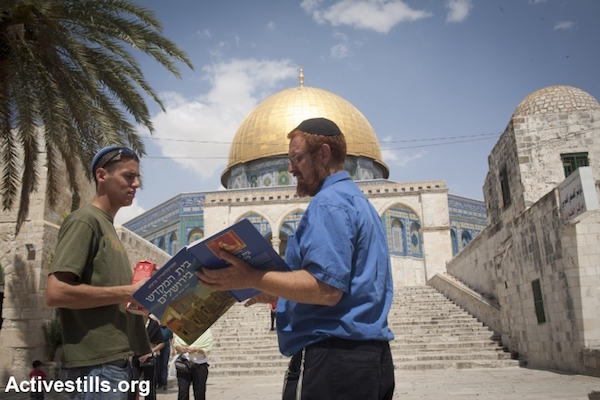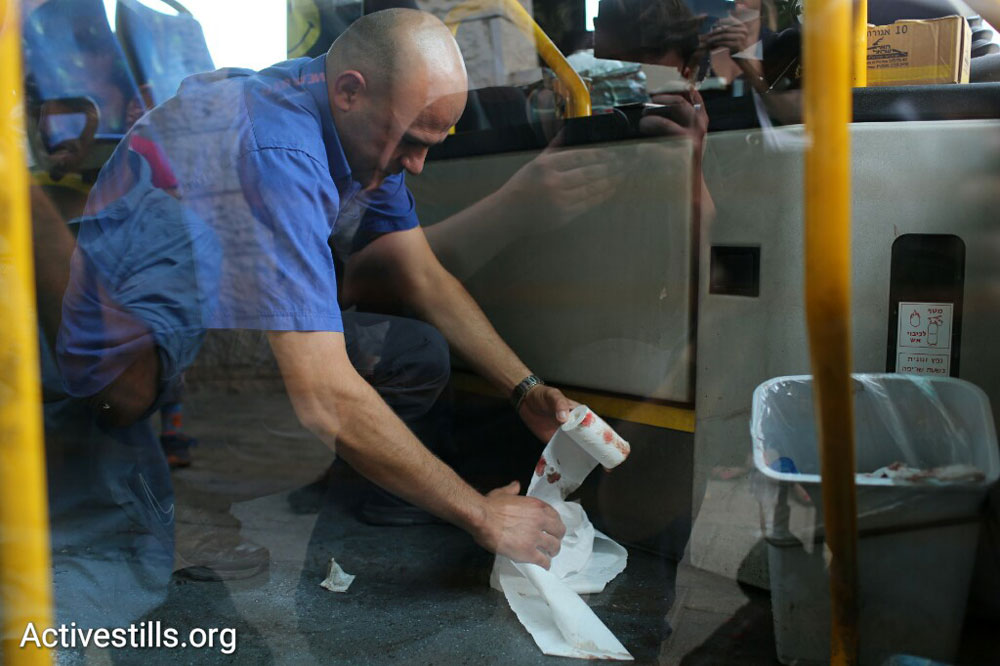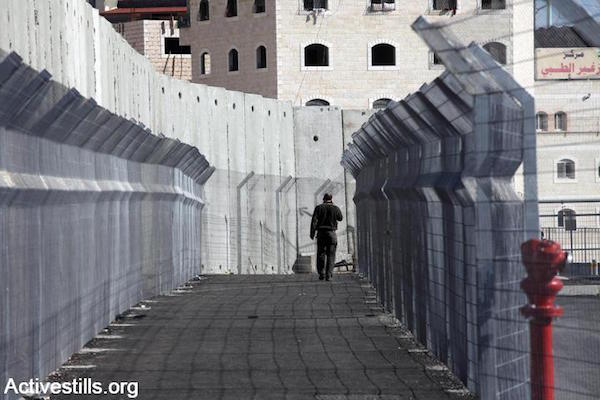The current events in Jerusalem have a political history and context. Attempts to attribute the violence to some kind of Palestinian pathology while ignoring other factors is a recipe for making things worse. A response to Jeffrey Goldberg.

Jeffrey Goldberg wrote a powerful piece in The Atlantic last week claiming to scrutinize Palestinian violence through the history of Jewish and Arab ties to the Temple Mount/Haram al-Sharif over the past 100 years. (“The paranoid, supremacist roots of the stabbing Intifada,” the headline reads.) Goldberg starts by discussing Palestinian “paranoia” over Israel’s actions in Jerusalem and ends with a broader, more common claim: that the Palestinian refusal to recognize Jewish ties to the land of Israel is the primary source of the conflict’s intractability, replete with its frequent rounds of violence.
There are many holes in this theory, and I’d like to point some of them out. But first a word of caution. I recently got the impression that some of my past writing has downplayed the importance of religious sentiments in leading to violence and I’d like to avoid repeating that mistake. I do not deny that some Palestinians reject the very idea of any Jewish ties to the land, although that is way less common among the PLO and the Palestinian-Israeli political leadership, to which Goldberg refers. However, it’s only fair to point out that there has never been any formal Israeli recognition of historical Palestinian ties to the land. The belief that Palestinians are invaders or mere guests in this land and that their own ties to the Temple Mount are a political hoax is widely held in Israel’s right wing.
Furthermore, history has proven that Palestinian fears about Jewish intentions regarding the Temple Mount and Old City of Jerusalem were not entirely irrational. There is a large, powerful camp in Israel that would like to change the status quo on the mount; it includes more than half of the Likud party, which has always been obsessed with the Temple Mount. Polls find that an overwhelming majority of the national-religious public supports Jewish visits to the site, and one-fifth have already visited it.

There are also those who would support way more radical actions: between 1982 and 1984 Israel’s Shin Bet uncovered no fewer than three Jewish terrorist groups that sought to blow up the holy mosques. The most famous of them was the Jewish Underground, which included well known public figures, at least two of whom went on to become members of Knesset. The Underground got as far as assembling explosives and surveilling the site in preparation for an attack. Today there is a new generation of Jewish fundamentalists: Before the 2013 elections I published a video on +972 showing a candidate for the Jewish Home party speaking on television about destroying the mosques on the Temple Mount.
The growing interest in the Temple Mount by dominant Israeli political forces hasn’t been lost on Palestinians, whose fears and concerns have been fueled by large-scale excavations Israel is conducting in the area (though not below the mosques themselves). Less than a month before the outbreak of the current escalation, and under pressure from his right-wing constituents, Defense Minister Moshe Ya’alon outlawed a couple of Palestinian organizations that operated on Temple Mount. Two weeks ago, Elad, a right-wing settler organization identified with the Right, scored a major court victory and won the rights to administer archeological activities near the Western Wall. For years Elad has been involved in efforts to evict Palestinian families in the nearby neighborhood of Silwan.
Does any of that justify attacks against Jewish civilians? Certainly not. My point is that Palestinian fears over Israeli plans for the holy site aren’t entirely unreasonable. It’s true that some elements of the formal and informal arrangements governing the Temple Mount and its surroundings have been left intact over the years. Others have changed, and the pressure from the Israeli side to do so was clear and out in the open for anyone to see. You don’t have to be paranoid to sense it all.
***
Yet even in this context, many Palestinian understand the current escalation as political and not religious. I recommend reading this interview with Supreme Sharia Judge of the Palestinian Authority Dr. Mahmoud al-Habash, a former Hamas cleric. While denying the Jewish narrative regarding the Temple Mount, Dr. Habash is ready for a political compromise over the holy site.
Just like with demands to recognize Israel as a “Jewish State” (rather as “the State of Israel,” something the Palestinians already did in 1993), Goldberg’s insistence that the Palestinians abandon their historical narrative in favor of the Jewish or the Israeli one is an attempt to force on them a maximalist abstract notion which prevents the pragmatic, political compromise at hand.
And that’s exactly what’s missing from Goldberg’s piece. History and political context. A closer examination of the stabbing attacks raises serious doubts about the entire theory of religiously motivated violence born out of a Palestinian failure to accept Jewish ties to the land.

The largest share of stabbing attacks (19 out of 49 incidents, according to analyst Nehemia Gershuni-Aylho’s count) were carried out by Jerusalemites, who comprise less than 15 percent of Palestinians west of the Jordan River, excluding Gaza. (The second largest number of attacks, 12, were in Hebron and the surrounding settlements.) Do religious Muslims from Umm el-Fahm or Nablus care any less about Haram al-Sharif? Are they less “paranoid” or “supremacist?” It seems that some other factors are also at play here and should be taken into account when attempting to put the current wave of violence in context.
What actually makes Jerusalem and Hebron unique is that both have mixed Jewish-Palestinian populations, each with separate and unequal legal statuses. Following the 1967 war, Israel annexed the eastern part of Jerusalem (including the Old City) and more than 20 villages and towns surrounding it. What is referred to in the Israeli media as “East Jerusalem” is actually an area 10 times larger than what constituted the eastern part of the city under Jordanian rule, with more than 300,000 people living it, including over 50,000 refugees in the Shuafat refugee camp.
Although these people hold blue Israeli identity cards, they are not citizens, only “permanent residents” (a legal term usually reserved for foreigners). They cannot purchase land, participate in general elections, and if they leave the country for several years they risk of losing their status and never being able to return. Furthermore, East Jerusalem is one of the most neglected areas in Israel, with skyrocketing poverty and unemployment and a contemptuous lack of municipal services.
The last decade saw two developments in the city, the importance of which in changing the reality in Jerusalem cannot be exaggerated. The first is the construction of the concrete separation wall between Jerusalem and the West Bank, leaving almost a third of the Palestinians in a no-man’s land, cut off from both Jerusalem and the PA — without municipal services at all. These neighborhoods, along with those left fully on the West Bank side of the wall, have become hotbeds of lawlessness, ranging from unauthorized and unsupervised construction to criminal activity. Israeli police don’t serve and protect the Palestinian population in these areas: when police do go in they enter military style to make an occasional arrest, and then leave.

The second important development was a sharp increase in the number of Jewish settlers living in the heart of Palestinian neighborhoods, from Sheikh Jarrah to Silwan and Mount Scopus, and of course, the Muslim Quarter of the Old City. Houses (and sometimes even rooms in apartments) are purchased or confiscated in shady scams and legal maneuvering, their Palestinian tenants evicted. (Just last night another couple of Palestinian families were thrown out of their homes.) Often, right-wing organizations actually pay Jewish tenants a monthly fee for “holding onto” those assets until a critical mass of Jews settle the neighborhood.
Peace groups have warned of these developments for several years, claiming again and again that they would lead to an outbreak of violence. Lefty Jews protested every weekend in Sheikh Jarrah and other neighborhoods; one of their common slogans was “Jerusalem will not become Hebron.” Nobody listened, especially not those who are talking about Palestinian incitement these days. Curiously, six years ago or so, I heard that Jeffrey Goldberg was in Israel and invited him to visit Sheikh Jarrah. He wrote back saying that he had already visited the protests there. I have no reason to doubt him, but I wonder what lessons he learned there.
***
Contextualizing violence, which is what I am trying to do here, is not meant as a justification for it. On top of the loss of innocent lives, the events of the past few weeks will further poison relations between Jews and Arabs for years to come. If you believe that the two peoples are bound to live together here, you should be extremely concerned these days. This escalation, it seems, is spreading rather than dying out, moving beyond Jerusalem, Al Aqsa and Hebron. The denial of the political context of the events is likely to make things worse.
The Israeli government, just like Goldberg, is turning the violence into a kind of pathology, claiming to know something profound about the inner psyche of every Palestinian (paranoid, supremacist). This approach to conflicts, especially ones involving ethnic minorities, has led to disastrous consequences time and time again, yet it remains popular because it allows us to avoid meaningful changes that are costly and complicated. My fear is that it will take many more casualties, Jews and Palestinians, before Israel will be willing to consider a different outlook.

